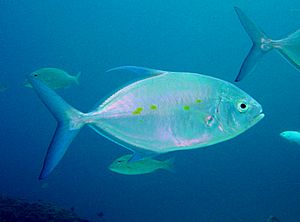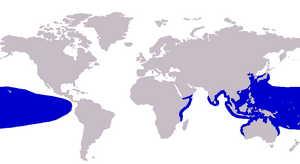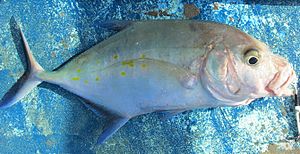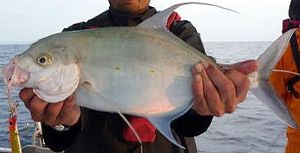Island trevally facts for kids
Quick facts for kids Island trevally |
|
|---|---|
 |
|
| Conservation status | |
| Scientific classification | |
 |
|
| Approximate range of the island trevally | |
| Synonyms | |
|
The island trevally (Carangoides orthogrammus) is a type of fish found in the ocean. It is also known as the island jack, thicklip trevally, or false bluefin trevally. This fish belongs to the jack family, called Carangidae.
Island trevallies live in the warm, tropical parts of the Indian Ocean and Pacific Ocean. You can find them from Mozambique in Africa all the way to Hawaii and the Revillagigedo Islands near Mexico. They usually live around islands, not close to big continents. They like lagoons and reefs. This fish can grow quite large, up to 75 centimeters (about 30 inches) long and weigh about 6.6 kilograms (14.5 pounds). You can spot them by their pointy snout and yellow spots. Island trevallies often swim in small groups. They eat small fish and crustaceans like crabs and shrimp. People often catch them for food using nets or fishing lines.
Contents
What is the Island Trevally?
The island trevally is part of a group of fish called Carangoides, which are commonly known as jacks and trevallies. These fish are all part of the larger jack and horse mackerel family, Carangidae. This family is then part of an even bigger group called Carangiformes.
Scientists first described the island trevally in 1881. Two American scientists, David Starr Jordan and Charles Henry Gilbert, gave it the name Caranx orthogrammus. Later, scientists decided it fit better in the Carangoides group. Over the years, other scientists thought they had found new types of fish, but it turned out they were also island trevallies. So, the original name given by Jordan and Gilbert is the correct one today. The name "island trevally" comes from where it lives, which is usually around islands. Its scientific name, orthogrammus, means "straight lined" in Greek.
What Does the Island Trevally Look Like?
The island trevally is a medium-sized fish. It can grow up to 75 centimeters (about 30 inches) long and weigh around 6.6 kilograms (14.5 pounds). It looks a bit like another fish called C. ferdau, but the island trevally has bright yellow or brassy spots on its body, which helps tell them apart.
This fish has a body shape that is a bit flat from side to side, like a compressed oval. Its back is more curved than its belly, and its snout is usually rounded. The fin on its back, called the dorsal fin, has two parts. The first part has eight stiff spines, and the second part has one spine and 28 to 31 soft rays. The fin on its belly, called the anal fin, has two small spines that are separate, then one spine and 24 to 26 soft rays. The fins near its head, called pelvic fins, have one spine and 21 or 22 soft rays.
The island trevally has a special line along its side called the lateral line. This line helps it sense movement in the water. Its body is covered in scales, but the area under its chin and near its belly fins is usually smooth without scales. Adult island trevallies have noticeably thick lips. Inside their mouths, they have narrow bands of small, brush-like teeth. As they get older, these teeth become less noticeable.
The top part of the island trevally's body is a pale blue-green color. Its belly is more silvery. Adults have several large, oval-shaped yellow or brassy spots along their sides. Sometimes, you might see 9 or 10 dark stripes going down its body from head to tail. The soft dorsal fin, anal fin, and tail fin are pale brownish-blue or even bright blue. All the other fins are pale green or clear.
Where Does the Island Trevally Live?
The island trevally lives in the warm, tropical and subtropical waters of the Indian Ocean and Pacific Ocean. In the Indian Ocean, you can find it along the east coast of Africa, up to the Gulf of Aden, and also around India and Sri Lanka. It also lives throughout Southeast Asia, Indonesia, and northern Australia.
In the Pacific Ocean, this fish is found from Taiwan and Japan all the way to Hawaii and the Revillagigedo Islands near Mexico. It also lives around many other islands in the Pacific.
As its name suggests, the island trevally usually lives around islands that are far from big landmasses. These islands might be formed by volcanoes or are small pieces of land left over from continents moving apart. These islands often have beaches, reefs, lagoons, and even estuaries. The island trevally can be found in all these places, as well as on reefs that are a bit deeper, up to 50 meters (about 164 feet) deep. In Hawaii, these fish are less common inside protected bays. They prefer to be a bit further out in the ocean. Sometimes, island trevallies are attracted to special devices that people put in the water to gather fish for fishing.
Life and Diet of the Island Trevally
The island trevally can swim alone or in small schools (groups) through its habitat. When they swim in schools, they can make up a large part of the total fish weight in that area.
This fish eats small fish and crustaceans. What they eat exactly can change depending on where they live. For example, one study in New Caledonia found that island trevallies mostly ate fish (98%), with only a small amount of crabs and shrimp. But a study in Hawaii showed they ate more crustaceans (almost 65%), including crabs, shrimp, and mantis shrimp, and fewer fish (about 32%). They also ate a small amount of cephalopods like squid. Scientists think that different types of fish in the same area might change what they eat to avoid competing too much for food.
Not much is known about how island trevallies reproduce or how fast they grow. Scientists only have a general idea that they might lay their eggs around March in the Solomon Islands.
The island trevally is somewhat important for fishing in the areas where it lives. People often catch them using fishing lines, trawl nets, or other local fishing methods. They are usually caught by accident when people are trying to catch other types of fish. So, the number of island trevallies caught is often small compared to the main fish that people are trying to catch. In most places, there aren't exact records of how many island trevallies are caught. When caught, the fish is sold fresh, dried, or salted. Many people think it is a good fish to eat.
See also
 In Spanish: Carangoides orthogrammus para niños
In Spanish: Carangoides orthogrammus para niños




